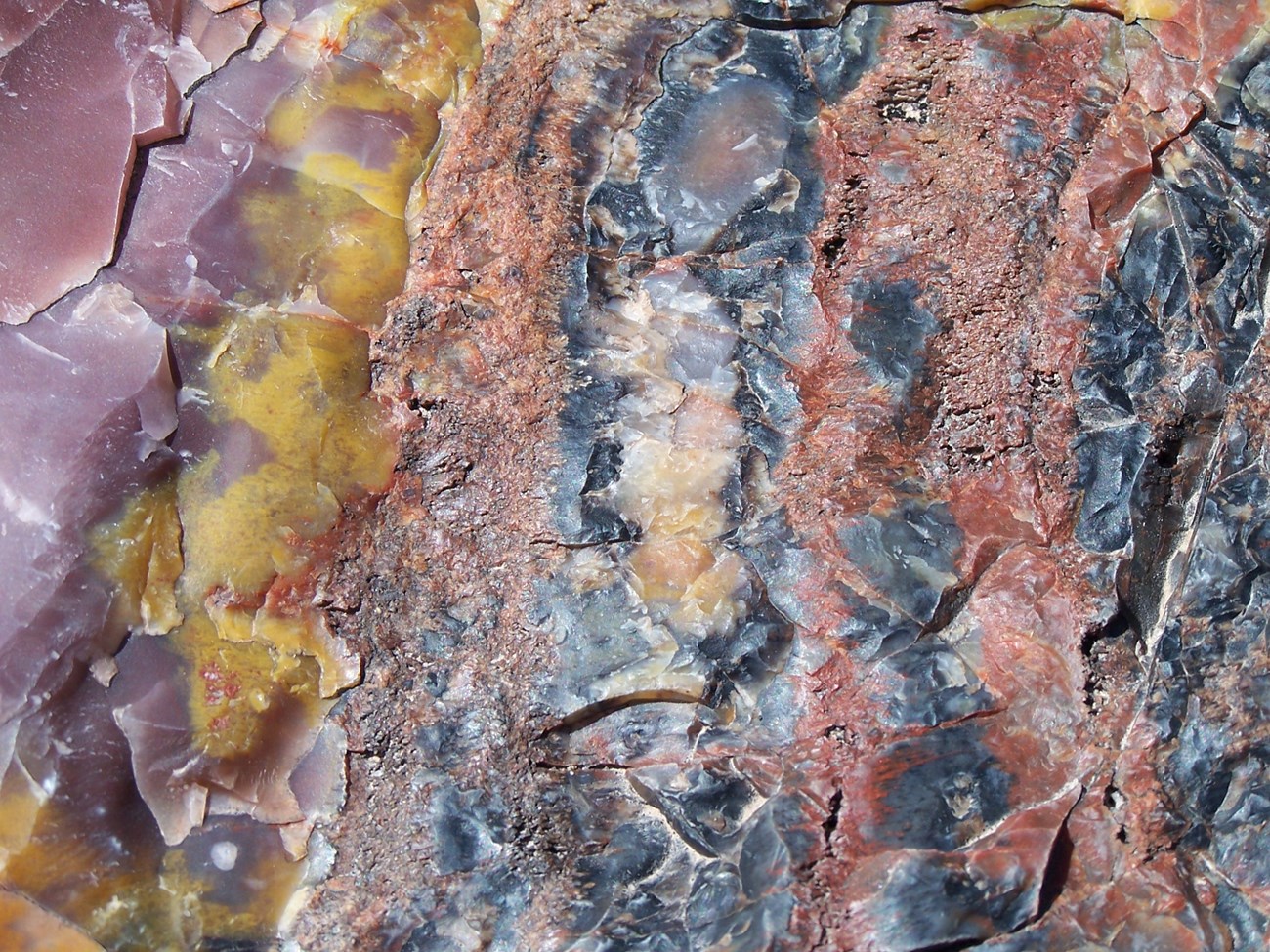
Introduction
Many minerals are coveted around the world for their striking beauty, rarity, and gem quality. But what is a mineral?
Minerals are formed naturally by geological processes. A mineral is a homogeneous solid that can be made of single native element or more usually a compound. Minerals make up Earth's rocks and sands, and are an important component of soils.
5 characteristics required of all minerals
- Be naturally-occurring (man-made substances such as steel are not minerals)
- Be Inorganic (not living, or from plants or animals)
- Be solid at room temperature (usually)
- Have a typical ordered internal structure (atoms have an orderly, repeated geometric pattern) which generally forms crystals
- Have a definite chemical composition (may vary within given limits) that is the same everywhere the mineral occurs
Fundamental Concepts
-
Nonsilicate minerals: A mineral without silicon (Si).
-
Silicate: Refers to the chemical unit silicon tetroxide, SiO4, the fundamental building block of silicate minerals. Silicate minerals make up most rocks we see at the Earth's surface.
Physical Properties
Minerals are identified and described according to their physical properties of:
- Cleavage: The tendency of a mineral to break (cleave) along weak planes.
-
Color: Most minerals have a distinct color while others are variable in color.
-
Hardness: A measure of a mineral's resistance to scratching. This is measured by scratching it against another substance of known hardness on the Mohs Hardness Scale
-
Luster: The reflection of light from the surface of a mineral, described by its quality and intensity. Luster is described as metallic, glassy, dull, earthy, etc.
- Streak: refers to the color of the residue left by scratching a mineral on a tile of unglazed porcelain, like a piece of chalk.
- Specific gravity: the ratio of the density of a mineral to an equal volume of water
To many, the National Park System is one of America's favorite mineral collections which can be viewed in the various rock formations and features around the country.
Natural objects, such as rocks and minerals, contribute to the beauty and wonderment of the National Parks and should be left, as they were found, so that others can experience a sense of discovery.
Common Minerals
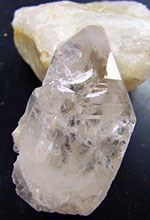
Photo courtesy of Tina Kuhn
Quartz
Quartz is one of the most common minerals in the Earth's crust. It is made of silicon dioxide (SiO2), otherwise known as silica. Varieties of quartz based on color include: amethyst (purple), smoky quartz (grey), rose quartz (pink), and citrine (yellow-green). Quartz has a glassy luster and a hardness of 7.
Quartz occurs in all three rock types and and can be seen in parks such as:
- Glacier National Park, Montana [Geodiversity Atlas] [Park Home]
- Black Canyon of the Gunnison National Park, Colorado [Geodiversity Atlas] [Park Home]
- Great Smoky Mountains National Park, North Carolina [Geodiversity Atlas] [Park Home]
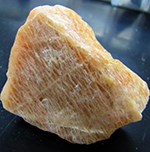
Photo courtesy of Tina Kuhn
Potassium feldspar
Potassium feldspar (or alkali feldspar or K-spar) is a member of the feldspar mineral family and is a silicate mineral. It contains a considerable amount of potassium and is typically pink-salmon to white in color. Potassium feldspar has a hardness of 6. The crystals are stubby prisms and have a streaky appearance called perthitic texture (as seen in image on the left).
A significant amount of potassium feldspar is found in the slope sediments and granite at:
-
Acadia National Park, Maine [Geodiversity Atlas] [Park Home]
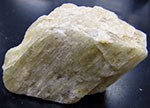
Photo courtesy of Tina Kuhn
Plagioclase feldspar
Plagioclase is a member of the feldspar mineral family. Plagioclase feldspars are yet another silicate that contains considerable sodium or calcium. Plagioclase crystals are stubby prisms, generally white to gray and have a glassy luster.
Plagioclase feldspar can be found in the igneous and metamorphic rocks at:
- Grand Teton National Park, Wyoming [Geodiversity Atlas] [Park Home]
- City of Rocks National Reserve, Idaho [Geodiversity Atlas] [Park Home]
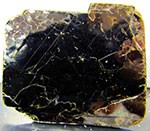
Photo courtesy of Tina Kuhn
Micas
Micas are another group of silicate minerals composed of varying amounts of potassium, magnesium, iron, aluminum, silicon and water. All micas form flat, sheet like crystals that peel apart along one cleavage plane into individual smooth flakes. Biotite (pictured to the left) is a black or brown mica; muscovite is light-colored or clear mica. Mica is so soft (2.5 on Mohs scale) that it can be scratched with a fingernail.
Mica typically occurs in metamorphic and igneous rocks. Biotite and muscovite are two of the primary minerals in the metamorphic rocks at:
- Mount Rushmore National Monument, South Dakota [Geodiversity Atlas] [Park Home]
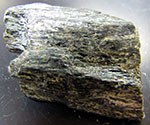
Photo courtesy of Tina Kuhn
Amphiboles
The amphiboles are a family of silicate minerals that form prism or needle-like crystals. Amphiboles are generally dark colored and contain iron, calcium, and aluminum. Hornblende is the most common amphibole and is dark green to black in color. Amphiboles are common in igneous and metamorphic rocks.
Amphiboles can be found in the intrusive igneous bodies at:
-
Denali National Park and Preserve, Alaska [Geodiversity Atlas] [Park Home]
and in the metamophosed gneiss at:
-
Weir Farm National Historic Site, Connecticut [Geodiversity Atlas] [Park Home]

Photo courtesy of Tina Kuhn
Olivine
Olivine [(Fe, Mg)2SiO4] is a silicate mineral containing iron and magnesium. It is a green, glassy mineral that forms at high temperatures. It is common in basalt and ultramafic rocks. Gem-quality olivine is called peridote. A rock made up entirely of olivine is called dunite. Olivine most commonly occurs in igneous rocks and can be found in andesite at:
- Mount Rainier National Park, Washington [Geodiversitiy Atlas] [Park Home]
- Devils Postpile National Monument, California [Geodiversitiy Atlas] [Park Home]
As well as in basalt at:
- Yosemite National Park, California [Geodiversitiy Atlas] [Park Home]

Photo courtesy of Tina Kuhn
Calcite
Calcite is made of calcium carbonate (CaCO3). Generally white to clear, calcite is easily scratched with a knife. Due to the presence of carbonates (CO3), calcite reacts to most acids (such as hydrochloric acid, HCl) and effervesces on contact. Most seashells are made of calcite or related minerals. Calcite can be found in many cave and karst formations such as the calcite features at:
- Jewel Cave National Monument, South Dakota [Geodiversity atlas] [Park Home]
- Wind Cave National Park, South Dakota [Geodiversity atlas] [Park Home]
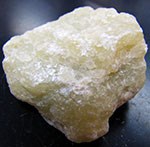
Photo courtesy of Tina Kuhn
Talc
Talc (Mg3Si4O10(OH)2) is the softest known mineral and can be scratched with a fingernail. Upon contact, talc has a distinctive greasy feel and a waxy/pearly luster. Talc is a foliated mineral and associated with metamorphic rocks. It is an alteration product from the metamorphism of minerals such as serpentine, pyroxene and amphibole. Talc can be found in talc schist at:
- George Washington Memorial Parkway, District of Columbia, Maryland, and Virginia [Geodiversity Atlas] [Park Home]
- National Capital Parks - East, District of Columbia [Geodiversity Atlas] [Park Home]
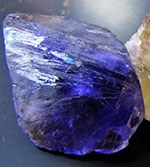
Photo courtesy of Tina Kuhn
Mohs Hardness Scale
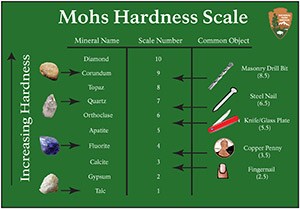
The Mohs Hardness Scale is used to help identify minerals. A mineral's hardness is a measure of a mineral's resistance to scratching. This is measured by scratching it against another substance of known hardness on the Mohs Hardness Scale. This simple graphic outlines the index minerals and common objects used to determine a mineral's hardness. Learn More >
-
Color Graphic [1.09 MB JPEG]
-
Graphic for Printing [890 KB JPEG]
Related Links
-
Bryce Canyon National Park, Utah [Geodiversity Atlas] [Park Home]
-
Petrified Forest National Park, Arizona [Geodiversity Atlas] [Park Home]
Last updated: August 26, 2025
